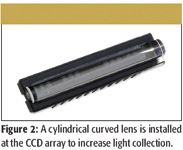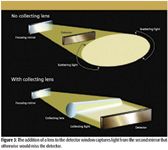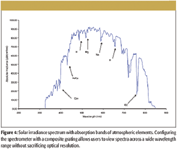How Optical Advances Helped Deliver the Promise of Miniature Spectrometers
Performance gaps in the industry's earliest miniature spectrometers today have been mitigated by the ongoing improvement of gratings, coatings, mirrors, and other spectrometer bench optical components.

When miniature spectrometers were introduced to the instrumentation market in the 1990s, they benefited from a sort of perfect storm of technological circumstances. The development of detectors for mass-volume markets lowered overall system costs dramatically, and the growth of fiber optics made it much easier to "guide" to the spectrometer the light that interacts with samples. Even the evolution of personal computers — which became faster, smaller, and more convenient — allowed spectrometers to process high-speed, high-resolution spectral data.

Rob Morris
Yet advances in optics perhaps have played an even more significant role in the evolution of miniature spectrometers. Today, because of new and improved optical bench components and designs, miniature spectrometers are much more than clever curiosities. They are robust analytical instruments found around the world in laboratories, on process lines, and in the field.
Conventional Wisdom Gets in the Way
One of the advantages of being a novice is that you don't know enough to be limited by conventional thinking. That certainly was the case at my company and other early manufacturers of miniature spectrometers. We were smart and resourceful, but we really weren't experts in the "contributing-regularly-to-refereed-journals" sense, in the field of spectroscopy. So, when a customer had a particular need, the first thought wasn't why that requirement couldn't be met, it was more about wondering why it hadn't been done before.
Not surprisingly, the miniature spectrometer pioneers became very good at solving application problems. They already had proved they could make a miniature version of a Czerny–Turner optical bench, an innovation that some very smart people had dismissed, so why not enhance or change the optical components in that spectrometer bench as well?
Thus began a two-decades-long series of improvements, innovations, and insightful applications of new optical technologies that have yielded the highest-performing, most robust miniature spectrometers ever.
And optical components have been at the heart of it all.
Improving Detector Performance
Charge-coupled devices (CCDs) are the detector of choice for miniature spectrometers, offering the advantages of small size, modest pricing, and suitable sensitivity for a wide range of applications. Still, CCDs aren't perfect. Performance tradeoffs can be significant. However, imaginative use of optical coatings and components helps to mitigate those compromises.
Optical Coatings
Although CCDs have the advantage of low levels of readout noise, their polysilicon capacitors absorb UV light and limit response below 350 nm. One remedy to this problem is to coat the CCD array with a phosphor to absorb UV light and emit visible light. This results in a detector with good UV response for many applications. Further refinement of such coatings (both the coating formulations and how and where the coatings are applied to the detector) will yield additional performance gains.
Order-Sorting Optics
Spectrophotometers typically use a diffraction grating for wavelength discrimination. Diffraction gratings are similar to prisms in that white light is spread into a spectrum by redirecting light at angles that are wavelength-dependent. However, each wavelength of light striking a grating is diffracted into several angles. The angles are whole-number multiples, or orders that vary with wavelength. So, for example, first-order light at 200 nm will be diffracted at angle 1 and at angle 2, which is exactly twice as large as angle 1. Angle 2 is also the same as the first-order angle taken by light at exactly twice the wavelength, or 400 nm. If the application requires measurements at 400 nm, and if 200-nm light is also present, then the signal at the pixel in question will include contributions from both wavelengths. (If, on the other hand, there is no deep-UV light, then only 400 nm will be detected.)
The second-order light typically is removed by using filters. For folks using scanning monochromators, accounting for second- and third-order is as simple as popping in the appropriate bandpass blocking filter. But for full-spectrum devices such as miniature spectrometers, this was not an option. Instead, bandpass filters had to be moved into the optical bench light path during an experiment — a suitable solution, but perhaps not as elegant as some other approaches.
Dichroic filters provided another option to the order-sorting challenge. Dichroic filters selectively transmit or reflect light according to their wavelength. These filters can be patterned onto a single substrate, such as a linear variable filter (LVF), that is applied to the CCD's window. LVFs can be designed to match the dispersed spectra and provide the correct blocking at each pixel in an array (versions designed for 200–850 nm and 350–1000 nm are available today). The benefit to this technology is that the filter acts as a second-, third-, and higher-order filter, and because the filter is installed at the time of manufacture, there's never any need to adjust it. Transmission efficiency is affected only marginally.
The development of LVFs for miniature spectrometer optical benches inspired another application: a discrete version of the LVF for use elsewhere in the spectrometer setup. With the ability to combine high-pass and low-pass linear variable filters, manufacturers could use the dichroic technology to spectrally shape the excitation energy from broadband sources used for cuvette-based fluorescence. Now you could manually adjust the center and bandpass wavelengths in an LVF filter carrier (fixture) installed at the cuvette holder.
Collection Lenses
Many years ago, I had a boss who would tell prospects that having too much light is a spectroscopist's dream. What he meant is, with the CCD-array detectors common to miniature spectrometers, having too little light is always a bigger challenge than having too much. After all, you can't miraculously bend the laws of physics to produce more photons than what you started with. Still, you can optimize your optical bench to capture every last photon possible so it reaches the detector. That's what spectrometer benches are designed to do.
In a crossed Czerny–Turner optical bench (the design typical of most miniature UV–vis spectrometers; see Figure 1), the bench directs broadband (white) light through a narrow entrance slit onto a diffraction grating and focuses the spectra onto a detector array. All the monochromatic light falls across the pixels illuminated by the slit image.

Figure 1
In the CCD arrays typical to miniature spectrometers, the width of the pixels relates to optical resolution and the height of the pixels relates to sensitivity (pixel well depth also is related to performance, but that's a more detailed discussion for another day).
Here's the rub: The slit image in a miniature spectrometer is typically "taller" than the height of the pixels in the linear CCD arrays; that is, the height of the beam coming from the focusing (second) mirror is greater than the array can efficiently collect. For example, in the case of the Sony ILX511b linear CCD-array, the pixel elements are 200 µm tall. In a spectrometer with a 25-μm entrance slit, the image reaching the detector can be as much as 1000 μm tall. Imagine how much more sensitive your system would be if you could capture all those "extra" photons that never make it to the detector.

Figure 2
The solution was relatively simple: add a collection lens to the detector (see Figure 2). Today, most miniature spectrometer manufacturers offer a cylindrical, aberration-free lens that is fixed to the detector to focus the image from the tall slit onto the shorter detector elements. Depending upon the optical bench configuration, this helps increase light-collection efficiency considerably (see Figure 3). In some testing, efficiency was increased by as much as 10× compared with a lens-free setup. In fact, the lens is so efficient as a light collector that in some high light-level applications — laser characterization, for example — the lens is intentionally left out of the bench. Maybe you can have too much light, after all.

Figure 3
Improving Optical Bench Performance
Miniature spectrometer manufacturers recognized that optical bench enhancements weren't the only way to improve spectrometer performance and functionality. Other optical components in the bench, including gratings and mirrors, could be improved or redesigned for better effect.
Gratings
Diffraction gratings of various designs are common to spectrometers, including flat-ruled gratings and holographic gratings. Gratings have various blaze angles and efficiencies, and can be optimized for particular wavelength ranges.
Grating selection exists as a series of tradeoffs. The efficiency of the first-order grating diffraction is enhanced in one wavelength region, but decreases in another region. For example, a 600-line/mm grating blazed for optimum efficiency at 300 nm is <30% efficient at wavelengths greater than 575 nm. The same ruled-grating grooves tilted at an angle to accentuate the NIR region are >30% efficient from 530–1100 nm, but have low efficiency in the UV.
Groove density also influences the available blaze angles. As groove density increases, the wavelengths of efficient first-order spectra decrease. For example, a 3600 line/mm grating won't work well above 340 nm. For someone who wants good grating efficiency over a wider wavelength range, few viable options existed in those early days of miniature spectroscopy. Certainly there are gratings that disperse over a wide range, but at very low resolution and with significant order-sorting effects.
To solve this problem, optical engineers designed special composite gratings that have regions with different blaze angles. This yielded a grating with good efficiency over a wider wavelength range (200–1050 nm) than was otherwise possible with standard gratings. Spectrometer users could have their cake and eat it too, performing experiments across the UV-shortwave near-IR in a single, one-channel spectrometer without sacrificing optical resolution (see Figure 4). Add to the mix the order-sorting detector filters already available, and the result was a very versatile, high-functioning miniature spectrometer.

Figure 4
Optical Bench Mirrors
In the symmetrical crossed Czerny–Turner optical design, there are two mirrors that help move light around the optical bench on its way to the detector: the collimating mirror (first mirror), which makes parallel the light entering the bench and then reflects that light onto the grating; and the focusing (second) mirror, which focuses the light onto the detector plane.
In early miniature spectrometers, mirror selection was limited to standard, off-the-shelf options. Coated and dichroic thin-film mirrors helped change the equation. Depending upon the mirror type, signal response could be boosted at UV, visible, or near infrared wavelengths. These enhanced-response mirrors could be used at both first- and second-mirror positions.
Silver-coated mirrors have very high reflection values of >97% across visible and near infrared wavelengths, and over a wide range of angles of incidence. Silver mirrors produced using dichroic processes offered great versatility and robust performance.
A proprietary process developed by Ocean Thin Films (Largo, Florida) produces silver reflecting layers in dielectric thin films, retaining the high reflectivity characteristics of silver and offering the advantage of being tuned to reflect certain wavelengths. What's more, these dichroic mirrors absorb nearly all UV light, a characteristic that reduces the effects of excitation scattering in fluorescence measurements.
Another first- and second-mirror option produced using dichroic techniques utilizes a UV-enhanced aluminum design to significantly boost signal below 300 nm. (This same design is also tunable and can be applied to gratings as well.) Testing has shown as much as 10% UV response improvement compared with standard mirrors.
In addition to providing enhanced response at certain wavelength regions, the second mirror in a Czerny–Turner optical bench can be used to attenuate light at specific wavelengths, allowing users to shape the resulting spectrum according to their needs. This is an especially useful option when the application requires balancing of the spectral output without sacrificing signal-to-noise performance.
Miniature Spectrometers Grow Up
Where users once thought of miniature spectrometers as "toys" or gadgets, today people see them as the surprisingly sophisticated analytical instruments they've become. The younger generation of researchers, in particular, simply expects that miniature spectrometers will perform as well as standard spectrometers for most applications.
In a way, the early adopters of miniature spectrometers helped shaped the path that the technology has followed over the past two decades. Each application challenge yielded some new insight that could be built into future generations of products, with advances in optical coatings and components helping to elevate spectrometer system performance without significantly adding to the cost. Today, thanks in large part to better optics and bench designs, miniature spectrometers can be used everywhere from the depths of oceans to process lines in factories to the reaches of space — and even the surface of the moon.
What will the next generation of optical advances bring? The advances being pushed by today's mass markets will have a big impact. Imagine ever-lower cost and higher-performance image sensors, migration of computing to cell phone-sized electronics packages, technologies being driven by the need for optical memory and computing (diffractive optics and holography) and advances in quantum photonics-based materials (like photonic crystals).
Perhaps optical components inside the spectrometer could become fully adaptive, so the bench could modify itself to meet changing conditions or different needs. Certainly gratings, where the manufacturing art that produces them hasn't changed much over the last century, are fertile ground for new approaches. Higher grating efficiency, lower stray light, and even more freedom in controlling the pitch and blaze of each grating line would elevate grating performance to new heights. And already there are optical bench designs that accommodate interchangeable slits.
Just as miniature spectrometers helped make possible applications not feasible with conventional spectrophotometers, so, too, will the optical breakthroughs of today have even greater impact on how we sense and control our world tomorrow.
Rob Morris is Director of Marketing for Ocean Optics, Inc. He joined the company in 1995 and since then has contributed editorial material to Spectroscopy and various other industry publications.
